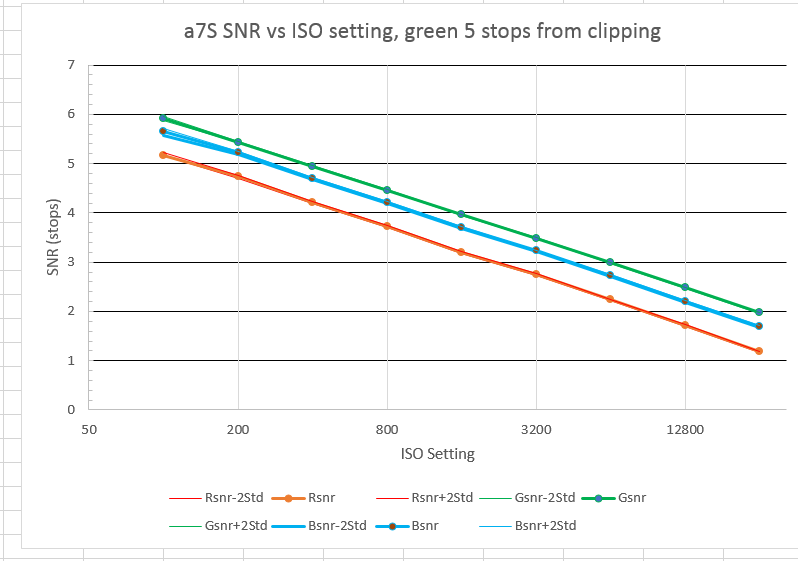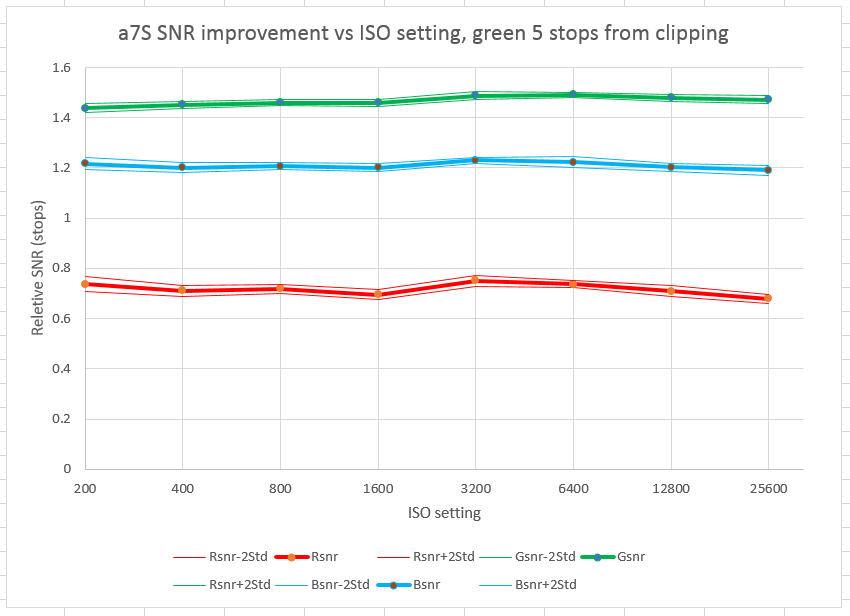Measuring read noise is fine, but by the time you can see the read noise, the photon noise is usually pretty bad. In fact, for me, the photon noise is more important as a measure of practical image quality.
Here’s a test that shows the combined effects of photon and read noise as a function of the camera’s ISO setting.
I set up the camera aimed at a white card, and defocus the lens. The light source is a Paul Buff Einstein studio flash unit, so that I am able to precisely control the light level and make series at various sensor averages. There’s no PC receptacle on the a7S, so I use a hot shoe to PC converter. The lens is the Leica 135mm f/3.4 APO. I employ a ND 400 neutral density filter to reduce the light level. I start out at f/4 and ISO 100, and adjust the strobe level to get the green channel about five stops down from full scale. I make 16 photographs of the out-of-focus card. Then I stop the lens down one stop and double the ISO setting. 16 more images. When I get to f/22 I start cutting the strobe power in half as a I double the ISO. I stop after ISO 25K.
As I said, I make 16 exposures for each data point, averaging the results from those exposures. As a side benefit of that approach, I can compute the standard deviation of the underlying single-exposure data for each data point, and plot that information on the graphs to give an idea of the possible sampling errors involved.
I bring one of the images into RawDigger, select a square in the middle that’s 200 pixels on a side, measure the mean and standard deviation of all four sets of pixels. I leave the selection where it was, and measure the same statistics for all the rest of the images. For each image, I computed the SNR; the mean is the signal, the standard deviation is the noise.
I normalized all of the data so that they were corrected for the actual exposure of the test images, as measured by the mean value of the pixels in the selection box. This calibrates out exposure variations caused by inaccuracies in the shutter and the aperture, gain of the amplifiers in the camera, and variations in strobe brightness caused by power line variation and recycling interval.
I plot the data, with the log (base 2) of the SNRs as the vertical axis, and the log (base 2) of the film speed as the horizontal axis.
The data I collected gives red counts of about 200, blue counts of about 400, and green counts of about 500. The mean, mean-plus-two-standard-deviations, and mean-minus-two-standard-deviations lines are plotted below. If the data is Gaussian, for a large sample, less than five percent of the results lie outside of the two lighter lines. You’ll note that the two-sigma lines lie almost right on top of the mean ones.
Exposure is proportional to the number of photons hitting the sensor. Photon noise is proportional to the square root of the number of photons hitting the sensor. Therefore, the signal-to-noise ratio if we’re well above read noise is proportional to the square root of the exposure. Here’s what the a7S data looks like if we subtract out the half-stop-per-stop effect of having fewer photons as the ISO setting goes up:
You can see that there is a small, but useful, improvement in the red channel and lesser improvements in the other two channels when the ISO is changed from 1600 to 3200.The bigger bump occurs in the red channel not because that channel is red, but because that channel is darker than the other two channels, more than 6 stops down from full scale. As the signal level gets lower, the read noise gets more important. At ISO 3200, the red channel’s signal-to-noise ratio (SNR) is under 3 stops, which is, in my opinion, about where good photographic quality ends.
So yes, the trick the A7S does when you go above ISO 1600 is useful. And no, the effect isn’t very big at the kind of SNRs you need to make photographs with high image quality. It appears that, given a certain amount of exposure (f-stop and shutter speed) there’s not much penalty for turning up the ISO knob as far as 25K, but not much benefit, either. Real photographs will verify this conjecture. Or maybe not – stay tuned/


What trick you mean by saying: “So yes, the trick the A7S does when you go above ISO 1600 is useful. “?
Sony has a cross-licensing agreement with Aptina:
http://www.dpreview.com/articles/6474906938/aptina-signs-patent-cross-license-agreement-with-sony
Aptina has a scheme for changing the conversion gain as a function of ISO setting:
http://www.aptina.com/products/technology/DR-Pix_WhitePaper.pdf
The a7S has a big drop in sensor-referred read noise when you turn the ISO control from 1600 to 2000:
http://blog.kasson.com/?p=6188
I suspect that Sony is using the Aptina technology in the a7S.
That’s the “trick”.
Jim